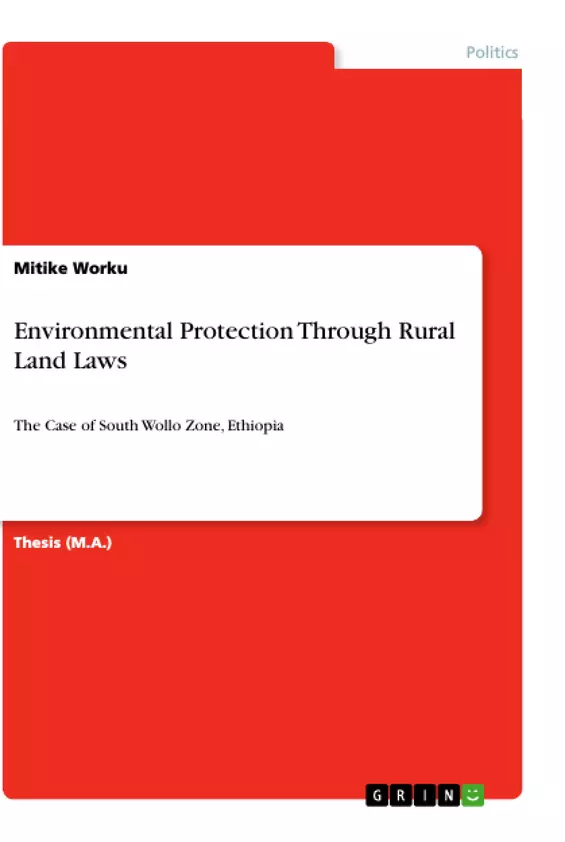Using qualitative method this study tries to find out whether the ANRS rural land laws' normative and institutional frameworks and their enforcement mechanisms are adequate or not in protecting environmental degradation in rural areas of South Wollo Zone, Ethiopia. Legal provisions of the ANRS rural land laws which deal with unlimited land use right, limited land distribution, land right registration and certification, obligations to conserve and protect the land, expropriation for environmental purpose, incentive and the existence of legal remedy will encourage the zone’s rural environmental protection. However this does not mean that such laws are comprehensive rather such laws fails to comprise all possible obligations of land users, lacks clarity and provided in general terms with weak remedies. There is also no cooperation mechanism or forum among stockholders in the areas of rural land administration and environmental protection. Much attention is given to land administration issues than environmental protection.
Environmental degradation related to rural land in Ethiopia in general and in ANRS, in particular, is reflected in the form of land degradation, loss, and degradation of water resources, deforestation as well as decline and/or loss of biodiversity. Ethiopia has designed a number of environmental laws. But such laws suffer from various defects which affect their ability to promote environmental protection. So efforts to use laws to protect the rural environment should look beyond just environmental statutes. Therefore seeking a solutions and studying rural land administration laws will be helpful to defy land degradation in rural areas.
The rural land and environmental protection institution also lack financial, material and manpower capacities which hold back to carry out its duties. Due to these reasons, the rural land administration and environmental protection institutional setup of the Zone remains inadequate to properly protect the rural environment. In relation to rural land environmental protection, the ANRS rural land laws are practically not enforced in the zone due to the legal gap and unclear less, insufficient and political will to enforce the rural land laws. So the rural land environment of the South Wollo Zone remains in peril so long as there is no effective and enforced rural land law, government commitment, and well-designed, empowered and coordinated institutions.
Inhaltsverzeichnis (Table of Contents)
- CHAPTER ONE: INTRODUCTION
- 1.1 General background
- 1.2 Statement of the problem
- 1.3 Research questions
- 1.4 Research objectives
- 1.4.1 General objective
- 1.4.2 Specific objective
- 1.5 Scope and limitation of the paper
- 1.6 Purpose and significance of the paper
- 1.7 Description of the study area
- 1.8 Design of the paper
- 1.8.1 Methodology
- 1.8.2 Data source
- 1.8.3 Felid data collection and sampling methods/techniques
- 1.8.3.1 Individual face to face interview
- 1.8.4 Research Analysis techniques
- 1.8.5 Organization of the thesis
- 1.8.6 Ethical consideration
- CHAPTER TWO: THEORETICAL FRAMEWORK
- 2.1 Land: meaning, nature, and importance
- 2.2 Land law, environmental law, and environmental protection
- 2.3 Enforcement mechanisms of rural land laws for the protection of the environment
- 2.3.1 Civil remedies
- 2.3.2 Criminal remedies
- 2.3.3 Administrative remedies
- 2.4 Rural Land tenure security and environmental protection
- 2.4.1 The private-public land discourse and environmental protection
- CHAPTER THREE: ENVIRONMENTAL PROTECTION THROUGH RURAL LAND LAWS IN ETHIOPIA
- 3.1 Environmental problems related to rural land in Ethiopia
- 3.2 Environmental protection through rural land laws in Ethiopia: the legal framework
- 3.2.1 The Constitution
- 3.2.1.1 Ethiopian land policy
- 3.2.1.2 Rural Land tenure security and environmental protection in Ethiopia
- 3.2.2 Federal rural land administration and use proclamation
Zielsetzung und Themenschwerpunkte (Objectives and Key Themes)
This study aims to evaluate the effectiveness of rural land laws in protecting the environment in the South Wollo Zone of the Amhara National Regional State. The study explores the normative and institutional frameworks of these laws, focusing on their enforcement mechanisms and their adequacy in addressing environmental degradation in rural areas.- The effectiveness of existing legal frameworks in protecting the environment in rural areas.
- The role of land tenure security and its impact on environmental protection.
- The challenges and opportunities related to land use planning and management in rural areas.
- The enforcement mechanisms of environmental protection laws and their effectiveness in practice.
- The impact of rural land administration on environmental degradation.
Zusammenfassung der Kapitel (Chapter Summaries)
Chapter One provides an overview of the general background, statement of the problem, and research questions surrounding environmental protection through rural land laws in South Wollo Zone. It also outlines the research objectives, scope, significance, and methodology of the study. Chapter Two delves into the theoretical framework, defining land, exploring the relationship between land law, environmental law, and environmental protection, and analyzing enforcement mechanisms of rural land laws. This chapter also examines the role of rural land tenure security and its connection to environmental protection, including the private-public land discourse. Chapter Three examines the legal framework for environmental protection through rural land laws in Ethiopia, analyzing the Constitution, Ethiopian land policy, and the Federal rural land administration and use proclamation. It further explores the existing environmental problems in rural areas, highlighting the challenges and opportunities for environmental protection.Schlüsselwörter (Keywords)
The key terms and concepts in this work revolve around the relationship between rural land laws, environmental protection, and their impact on land degradation in the South Wollo Zone. The research focuses on examining the legal framework, enforcement mechanisms, and the effectiveness of these laws in practice. Key terms include rural land laws, environmental protection, land degradation, land tenure security, enforcement mechanisms, land use planning, and institutional capacity.- Arbeit zitieren
- Mitike Worku (Autor:in), 2018, Environmental Protection Through Rural Land Laws, München, GRIN Verlag, https://www.grin.com/document/514602



